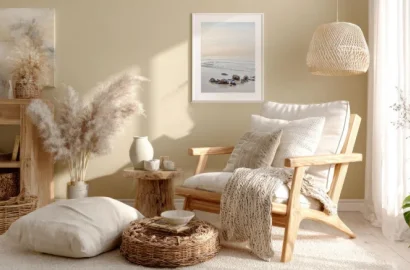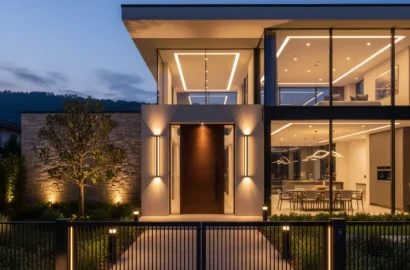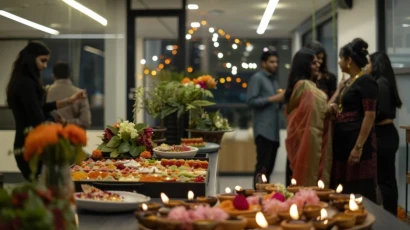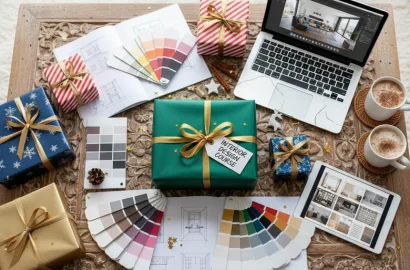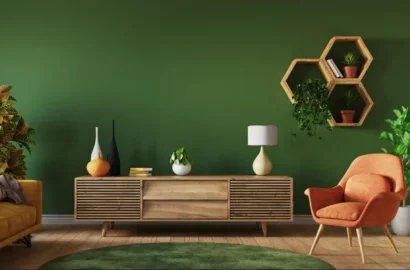Looking for inspiration for your design project? Let our list of interior design quotes come to your rescue. Read on for some words of wisdom from industry stalwarts and renowned designers.
Over the last several decades, interior design has successfully established itself as a popular career choice with a promising professional trajectory. However, embarking on a journey to transform spaces into living works of art requires more than just technical skills—it demands inspiration. And what better way to ignite your creative spark than by delving into the timeless wisdom shared by visionaries who have shaped the landscape of interior design?
On that note, we present to you a curated collection of the best interior design quotes from iconic personalities who have contributed to both the realm of design and interiors.
1. Inspiring Interior Design Quotes and What They Stand For
When seeking inspiration, the wisdom encapsulated in motivational quotes from industry stalwarts serves as an invaluable resource. While we remain aware that the interior design industry boasts an extensive array of influential figures, we’ve restricted our curated collection to 16 carefully chosen quotes to assist you in discovering the inspiration you seek.
So without further delay, let’s dive right in!
I. Charles Eames

The details are not the details. They make the design.
Charles Eames was an American architect and designer who holds the glory of creating multifunctional modern designs and revolutionising the furniture industry. Charles’ furniture design concept had a distinctive modern touch that utilised different details, new technologies, and materials like plywood and plastic to yield functional and affordable furnishing for the middle-class demographic. La Chaise, Lounge Chair Wood, and the Eames House are notable works that stand testament to Eames’ legacy.
This quote showcases the philosophy behind his detail-oriented and futuristic approach. Eames’ designs were primarily focused on human needs and served as an essential component of his design approach. The quote encapsulates the essence of his belief that meticulous attention transforms designs into excellence.
II. Dorothy Draper

I always put in one controversial item. It makes people talk.
Known as the first to professionalise the interior design industry, Dorothy Draper was an American Interior Designer who played a pivotal role in expanding the limits of the field and shattering societal expectations for women in her era. In addition to being the first to establish an interior design company, Draper is also credited with inventing the “Modern Baroque” style that largely finds application in public spaces and modern architecture.
Her quote mirrors her bold persona and vibrant design aesthetic that was characterised by exuberant colours and expansive prints. It stands as an encouragement for designers to embrace boldness, urging them to venture beyond their comfort zones and infuse attention-grabbing elements for a visually distinctive and impactful aesthetic.
III. Sister Parish

Behind every attractive room is a good reason.
Sister Parish, a notable American interior designer, left an indelible mark with accolades such as being the inaugural decorator for the Kennedy White House and catering to clientele like the Duchess of York, among other prominent socialites. Revered for pioneering the American Country style, characterized by a blend of luxury, comfort, and modernity, Parish achieved acclaim for her discerning design ethos, purposeful choices, and skilful balance of low and high styles.
Her quote highlights the idea that well-conceived designs are rooted in intention, enriching spaces with both aesthetic allure and purposeful meaning. It also emphasises the significance of functionality and practicality, transcending mere decoration.

IV. Mark Hampton

Real comfort, visual and physical, is vital to every room.
An American writer, illustrator, and designer, Mark Hampton was best known for his residential interior design catering to an impressive clientele like Brooke Astor, Estee Lauder, and H. John Heinz. Renowned for his coastal-inspired style, Hampton crafted spacious, airy rooms that exuded a modern, restrained, and elegant luxury. His signature approach involved the utilisation of natural materials and neutral tones, fostering a sense of freshness and sophistication.
In keeping with his design ethos, Hampton’s quote exemplifies the core principles of modern interior design. It emphasises that a well-designed room should not only be aesthetically pleasing but also deliver a tangible and comforting experience to its occupants.
V. Albert Hadley

The essence of interior design will always be about people and how they live.
Considered to be a key figure in the history of American interior design, Albert Hadley was an influential figure known for his exceptional “never less, never more” design philosophy. Hadley was recognised for his ability to blend traditional and modern elements, creating timeless and sophisticated interiors. Aside from his several creations, he is also known for co-founding the interior design firm Parish-Hadley Associates in collaboration with Sister Parish.
Akin to his enduring legacy, Hadley’s words here offer profound knowledge and wisdom for designers. The quote stresses that design decisions, from layout and functionality to aesthetics and decor, should be driven by a deep consideration of how people live and interact within a given space.
VI. Billy Baldwin

Be faithful to your own taste, because nothing you really like is ever out of style.
Billy Baldwin, acclaimed as “The Great American Decorator” or the “Dean of Indigenous Decorators,” was a renowned interior designer celebrated for his classicist and modernist aesthetic. His designs embodied a harmonious blend of comfort, simplicity, and luxury, characterized by clean lines and sleek styles. Baldwin’s distinctive approach featured signature elements like cotton, plain draperies, pattern-on-pattern, slipper chairs, and dark walls.
This quote serves as a poignant reminder to embrace authenticity, emphasizing that individualistic preferences pave the way for timeless and unique designs that reflect the true essence of one’s style. It also highlights the importance of not bowing down to trends unless it aligns with what one finds to be a pleasing design.
VII. Le Corbusier

The home should be the treasure chest of living.
A Swiss-French architect, Le Corbusier is one of the four pioneers of modern architecture. Known for his scientific and rational approach, he was the creative genius behind the development of Chandigarh, the capital city of the Indian states of Punjab and Haryana.
The quote highlights his deep commitment to his craft and aligns with his architectural principles that aimed to enhance the quality of life through thoughtful and functional design. It serves as a great inspiration for architects and designers alike and emphasises the profound significance of a home as a sanctuary where individuals find comfort, love, and a sense of belonging.

VIII. David Hicks

The best rooms have something to say about the people who live in them.
Credited for revolutionising interior design in the 60s and 70s, David Hicks was renowned for his use of bold colours, modern furnishings and mixing antiques into the design. Departing from the traditional English style, Hicks embraced modern hedonism, integrating exuberant prints, patterned carpets, and contemporary lighting.
The quote encapsulates Hicks’ approach and encourages intentional design choices that authentically mirror the inhabitants’ personalities. It reinforces the idea that a well-designed space goes beyond aesthetics, becoming a true expression of the individuals who make it their home.
IX. Juan Montoya

A room should never allow the eye to settle in one place. It should smile at you and create fantasy.
Renowned interior designer Juan Montoya, celebrated for blending Art Deco, Greek, and Mayan influences, is characterised by a minimalist approach that merges boldness with relaxation, achieving sophistication and comfort. His design philosophy, reflected in this quote, advocates for dynamic spaces that encourage exploration and movement.
Montoya’s eclectic style creates visually engaging environments, stimulating observers and fostering positive, imaginative experiences within the space. This quote encapsulates his design ethos, emphasising the importance of a well-designed space that captivates and invites exploration, leaving no room for boredom in the mind of an observer.
X. William Morris

No pattern should be without some sort of meaning.
William Morris, a prominent textile designer and craftsman, was a pivotal figure in the Arts and Crafts Movement, advocating for handmade production during the industrialisation era. He also played a crucial role in reviving textile arts in the Victorian era, favouring medieval artisanal techniques in dyeing and printing.
Willam’s quote brings to attention an essential aspect of intentionality in design, especially in the selection of patterns. This advice becomes particularly relevant in contemporary interior design where patterns are increasingly popular and emphasizes the impact that thoughtful pattern choices have on the overall coherence of a visual composition.
XI. Andrée Putman

For a house to be successful, the objects in it must communicate with one another, respond and balance one another.
A French interior and product designer, Andree Putman established herself as a renowned name in the industry with her minimalist interiors coupled with avant-garde furnishing. Putman’s work often blended classical and modern elements, and she was a pioneer in the use of sleek lines, neutral colours, and a sense of timeless elegance. Andrée Putman’s iconic projects include the interior design of Morgans Hotel in New York and the redesign of the Concorde aeroplane’s interior.
Characterised by simplicity, functionality, and a focus on form and materials, Andrée Putman’s quote aligns with the belief that a successful home requires elements that harmonise with each other while retaining their functional and aesthetic value.

XII. Vladimir Kagan

Chairs are uniquely the best expression of design. They encompass more of the challenges by which I live and work than any other single component of furniture.
Vladimir Kagan is an American furniture designer who significantly shaped the mid-century modern design movement. He was best known for his modern and innovative furniture designs, characterised by organic shapes, clean lines, and sculptural quality. Some of his famous designs include the “Contour Chair” and the “Serpentine Sofa.”
In this quote, Kagan stresses the pivotal impact of chair and furniture selection on a room’s visual appeal. He highlights the potential that furniture holds to either elevate or diminish overall aesthetics, underscoring the importance of careful consideration in choosing furniture for effective design.
XIII. Jean-Louis Deniot

Luxury is when it seems flawless; when you reach the right balance between all elements. Understated theatricality – that is what my luxury is all about.
Jean-Louis Deniot is a highly acclaimed French interior designer known for his sophisticated and timeless designs. Deniot is recognised for his ability to blend various styles and eras, creating luxurious and harmonious interiors. His work often features a mix of classical elements, contemporary aesthetics, and a keen attention to detail.
Elaborating on a luxurious style of design, this quote by Deniot asserts the paramount importance of harmony in creating luxurious spaces. He emphasises that is is only through harmony that luxurious interiors can look flawless and flow smoothly from one element to another.
XIV. Kelly Wearstler

Rawness and refinement are not opposite ends of a luxurious spectrum. They are two complementary features with which to populate a luxe environment.
Renowned for her maximalist interior design, Kelly Wearstler blends graphic elements and instinctual creativity, creating a unique niche in the modern minimalist scene. Her signature style orchestrates uncluttered spaces infused with multilayered focal points, offering a stimulating and sensory experience that sets her work apart in the design world.
Wearstler’s quote here perfectly encapsulates her approach to designing spaces. More often than not, luxury is associated with minimalist and refined aesthetics. Kelly’s words and design ethos steer away from the general norm, redefining the essence of luxury in interior design.
XV. Nate Berkus

Your home should tell the story of who you are, and be a collection of what you love.
Nate Berkus is an interior designer and television personality whose elevated aesthetic has given identity to several high-end residential projects. Marked by a rather vintage-inspired style, projects by Berkus typically incorporate warm neutrals, antique elements, and timeless accessories.
His quote underscores the essence of residential design, emphasising that a home should be an authentic reflection of its occupants’ personas. By seamlessly integrating elements that narrate the story of the inhabitants, Berkus emphasises the significance of personalisation in crafting truly meaningful and inviting living spaces.
XVI. Donna Karan

Design is a constant challenge to balance comfort with luxe, the practical with the desirable.
A renowned name in the fashion industry, Donna is celebrated for her effortlessly luxurious and feminine design ethos. Famed for body-conscious creations infused with comfort and simplicity, her pinnacle achievement is the Essentials line—a collection of seven pieces forming a versatile wardrobe. Though not an interior designer, her philosophy transcends disciplines.
Donna’s quote mirrors the universal design challenge: merging comfort and practicality with luxury and desire. In both fashion and interiors, the delicate equilibrium between functionality and opulence defines the essence of true luxury—where spaces, like wardrobes, seamlessly blend comfort with a touch of desire, creating enduring and appealing designs.

2. How To Get Started With Interior Design
Now that you have gained wisdom from leading interior designers, it’s time to apply those insights to your project. With the vast possibilities in the field, these tips serve as a valuable starting point for launching your design endeavour.
Here are some other steps you can take if you’re looking to formally pursue interior design.
- Familiarise yourself with the basics: Read books, magazines, and online articles about interior design to understand the basics, principles, and different styles. You can also explore design blogs and websites to stay updated on current trends and industry news.
- Take Online Courses: Many platforms offer interior design courses. Look for courses that cover fundamentals, space planning, colour theory, and materials. A good course should ideally also offer training in design software like SketchUp, AutoCAD, or room planning tools.
- Gain Practical Exposure: The best way to get a hang of the field is through hands-on practice. Look for internships or entry-level positions in interior design firms to get started. If you are an experienced designer, you can also offer your services for small projects to gain experience and build your portfolio.
- Build a Portfolio: A good interior design portfolio could be your ticket to better and bigger opportunities. Your portfolio should showcase your design projects, even if they are just personal projects or hypothetical scenarios. Include before-and-after pictures, floor plans, and any other relevant details that highlight your skills. For reference, we highly recommend taking a look at AND Learner Keerthi Viswanandha’s Residential Project.
While these tips can assist you in getting started, it is important to note that interior design is a creative field and your personal style and taste will play a significant role in your work. Therefore, don’t be afraid to experiment and find your unique design perspective. You can also refer to this guide to assist you in the process: Top 26 Interior Design Styles With Examples
Next Steps:
We hope our list of quotes from leading designers could help you find the motivation and inspiration you were looking for. In case of further assistance, here are some additional resources you can consider:
- Watch this session by Snehanshu Mukherjee, Founding Partner at T.E.A.M and Mansi Almadi, an Interior Designer at Studio Lotus
- Talk to a course advisor to discuss how you can transform your career with one of our courses.
- Check out our Interior Design courses – all courses are taught through live, interactive classes by industry experts.
- Take advantage of the scholarship and funding options that come with our courses to overcome any financial hurdle on the path of your career transformation.
Note: All information and/or data from external sources is believed to be accurate as of the date of publication.




